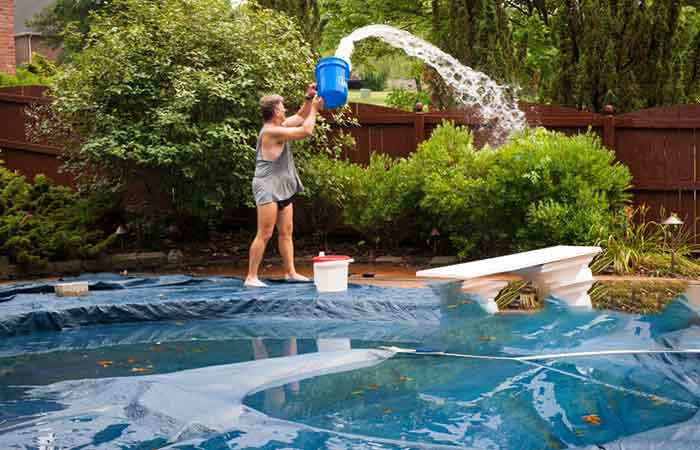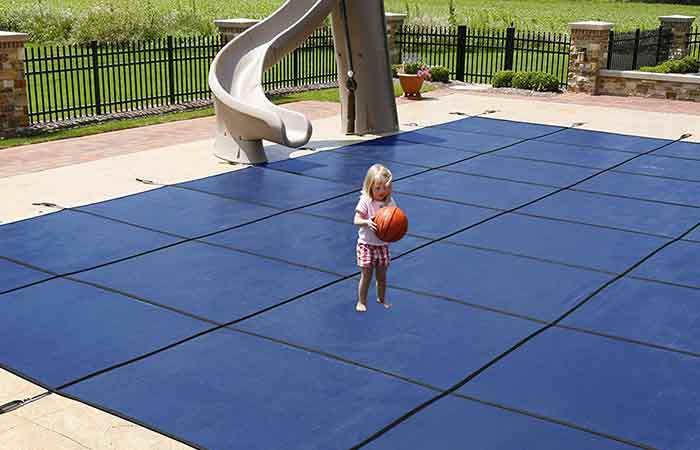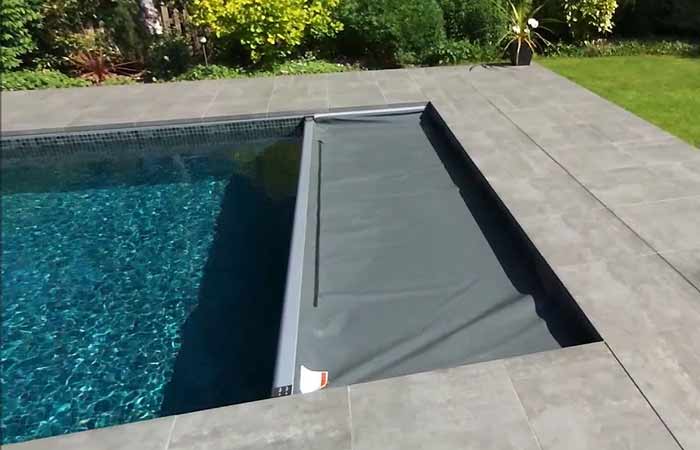How to get Water off Pool Cover + Prevention Tips
Pool covers are an important part of the pool cleaning process, and they also provide a safety barrier against accidental drowning. But it can be hard to get water off of a pool cover, especially if you have a large amount on there at once.
Luckily, there are several methods that can help remove excess water from your cover such as dumping it out with a bucket, using electric pumps, siphoning it, and using an electric pump.
Dumping is often easier than using an electric pump, but this method requires more time to complete. Pressure washing will usually take less than 30 minutes to do the job right. Which option should you pick? The following are details.
Siphoning the water from the pool cover
The first method to remove water from the pool cover is to siphon the water from a pool cover is to use an ordinary hose. This method will require that you access the edge of the pool cover and have a pipe that’s long enough to reach the top of the cover and have the other end in an emptying location.
To siphon the water from the pool cover, follow these steps:
- Manually remove any huge debris including branches, leaves or any other object.
- Attach a high-density object such as a stone or metal on one end. The attached object helps to force the hose pipe to get to the bottom of the water. Ensure the attached object does not block the hose pipe.
- Place it on a faucet then turn it on. The aim is to fill the pipe with water to get rid of any air which may hinder the continuous flow of water.
- With the water from the faucet still in the hose, and drop the end with the attached object into the water on the pool cover.
- Place the other end in an area that is free from any standing water. Ensure the hose’s end on the pool is higher than the other end for the water to flow.
- Once the water starts flowing out, place it at a low point until it has flowed out from the pool cover.
At all times, make sure the end on the pool cover is submerged to avoid sucking in any air which could stop the siphoning process.
Advantages
This method has following the advantages:
- It’s simple and affordable since all that is needed is a hose.
- It’s fast enough to empty the water from the cover in a few minutes.
- No tools are required because the pool cover can be lifted up slightly to access it. This makes this method ideal for those who rent their homes since they will not have to worry about damaging any part of the property.
- No risks involved- You don’t need to climb anything or use electricity of any kind with this method.
Disadvantages
This method has following disadvantages:
- If the hose end placed on the pool cover on its own, it can move around and allow air into the pipe. This will cause the siphoning process to stop.
- It’s not practical if you need to move a lot of water because this method will take longer than others and might require more time, effort or both.
- It doesn’t remove huge dirt from the cover.
If you don’t have any tools to work with, this is the best method to go for.
Using a bucket
Another simple method is to use a bucket to get the water off of the pool cover. This method can work well for small quantities of water, small pools and strong pool covers and it is relatively easy to do without any special equipment or tools.
A bucket will be required in order to remove all of the excess water on top of the covers by scooping out the water in repeated motions.

The bucket should have an opening that’s wide enough for pouring but not too large so as to cause spillage during transfer from one spot to another. The size also needs to fit within arm reach if standing overtop where there are no railing or other objects that might interfere with movement like chairs, tables, etc., which would make carrying the water difficult and even dangerous.
This method has no complex procedure as it there is no need to use any tools of any kind, and it should take a relatively short amount of time for small amounts of water.
As long as there’s ample space in which to work then this method will be effective at removing all excess water without causing too much mess since nothing other than the bucket needs to get wet by coming into contact with stagnant pools atop pool covers.
Using an electric pump to Drain pool cover
Another method you can employ for this task is to use an electric pump.
As with the other methods, you will need a hose that can be inserted into the water in order for it to be sucked from one place and put it somewhere else.
The main difference is how this method works: instead of using gravity or siphoning, which rely on pressure differences between two points, electricity does all the work for you by forcing the water from one end to the next.
The steps for this option are as follows:
1# Skim the top of the pool cover
First, remove dirt and debris on the pool cover to ensure that the electric pump has a clean surface to work with. This helps prevent clogging up the pump when you start the cleaning process.
2# Prepare the pump
Next up, you will need to attach a hose and insert it into the water on the pool cover, as well as connecting the other end of the hose to your electric pump. Check if there are any issues with the pump to gauge if it’s in working condition. Fix any damaged parts before turning on the pump.
3# Place the pump on the water
Electric pumps differ and there are some that come with a pipe that you simply need to place in the water while others come with a suction hose which is placed into the water instead.
Whatever approach has been used, place the suction end of the pump into the water on the pool cover.
4# Place the emptying end at a collection point
The other end of the pipe should be placed at a collection point such as large container or lawn where the water from the pool cover can flow to.
5# Connect the power and run the pump
Make sure you have a power cord that’s long enough to deliver power as from the house to the swimming pool. Turn on the pump and run it until all the water from the pool cover has been removed.
Once you’ve removed all the water from the pool cover, disconnect the pump from power and hose.
6# Clean up your pool cover once the water has been removed
Once you remove all of the water, take this opportunity to clean off any debris that may have accumulated on top of your pool cover while using an electric pump. You can clean the cover while It’s still on the pool or when off it.
7# Remove excess fabric if necessary
If there are folds in excess material at one edge (usually around corners), use scissors or shears to cut out these sections.
You can then remove the cover from the pool, treat the pool then dive in.
Using a Slide N Pump
You can also use a Slide N Pump to remove water from the pool cover. A Slide N Pump is a device that has an opening at one end, a suction tube on the other and brackets to hold it onto the shape of your pool.
The Slide N Pump device works like a hybrid of the electric pump and hose methods. It looks like a normal hand pump and works by pumping water from the pool cover into the pipes to eliminate the air. After that, the water will flow by itself to the location of your choosing.
If the water stops, you can simply pump it out with the Slide N Pump device.
You can do this in the following steps:
1# Prepare the work area
First, prepare two pieces of a hose for this task. One will be connected to the short end of the Slide N Pump tool. This part should be a bit short as it’ll go to the water on the pool cover then connect to the Slide N Pump. The longer end will go to the location of your choosing to empty the water in it.
2# Connect the pump and hoses
As directed above, connect the two hoses on either end of the Slide N Pump with the inlet being the shorter end while the outlet being the longer end. Place the shorter end into the water on the pool cover and the longer end at a location you have chosen to empty the water to.
3# Pump the water
Simply give the tool a few pumps and it will push the water into the pipes. You can then leave it flowing until it stops. If there’s more water on the pool cover which can be pumped out, continue working the pump until the water comes out completely.
4# Remove the pipes
After these steps, your pool cover should be ready for use. Simply remove the pipes and Slide N Pump device, clean the cover then use your pool.
How to prevent water from collecting on a pool cover
You can prevent water from collecting on a pool cover by using an elephant cover. As its name suggests, it’s a pool cover that is strong enough to withstand the weight of an elephant.

As such, the weight of water won’t be enough to make it sag inwards like it is with other pool covers.
Advantages of Elephant Pool Covers
The elephant pool cover has various advantages such as the following:
- The weight of water won’t be enough to make it sag inwards like with other pool covers. This means that the pool cover will have a greater lifespan because there is less strain on the material from being weighed down by water droplets, dirt and debris. As such, you’ll get your money’s worth out of this type of pool cover since it lasts longer than others.
- They’re also low-maintenance pool covers because they don’t get water droplets, dirt and debris sticking to them.
- Another advantage is that the elephant pool cover blocks out harmful UV rays from penetrating down into your swimming area which means you’ll have a healthy environment for swimmers who enjoy taking time off from work to cool off in their local pool.
- The last one may not be as important but it’s worth mentioning nonetheless: elephant pool covers are also an aesthetically pleasing option since this type of cover comes in various colors such as blue, black or green.
Disadvantages
On the downside, elephant pool covers are more expensive than other types and the cost of installation is hefty as well.
- Elephant pool covers come at a high price tag along with costly installation costs. The cost of an elephant cover ranges anywhere from $200-$800 depending on size. Installation fee per panel is about $80 per meter plus labor charges Heavy duty anchors recommended ($150+ each) with concrete installed at least 50cm deep into ground.
- They also require complex installation and are not as easy to get off of the pool for maintenance purposes.
Still elephant pool covers are among the best options for keeping water off your pool cover.




